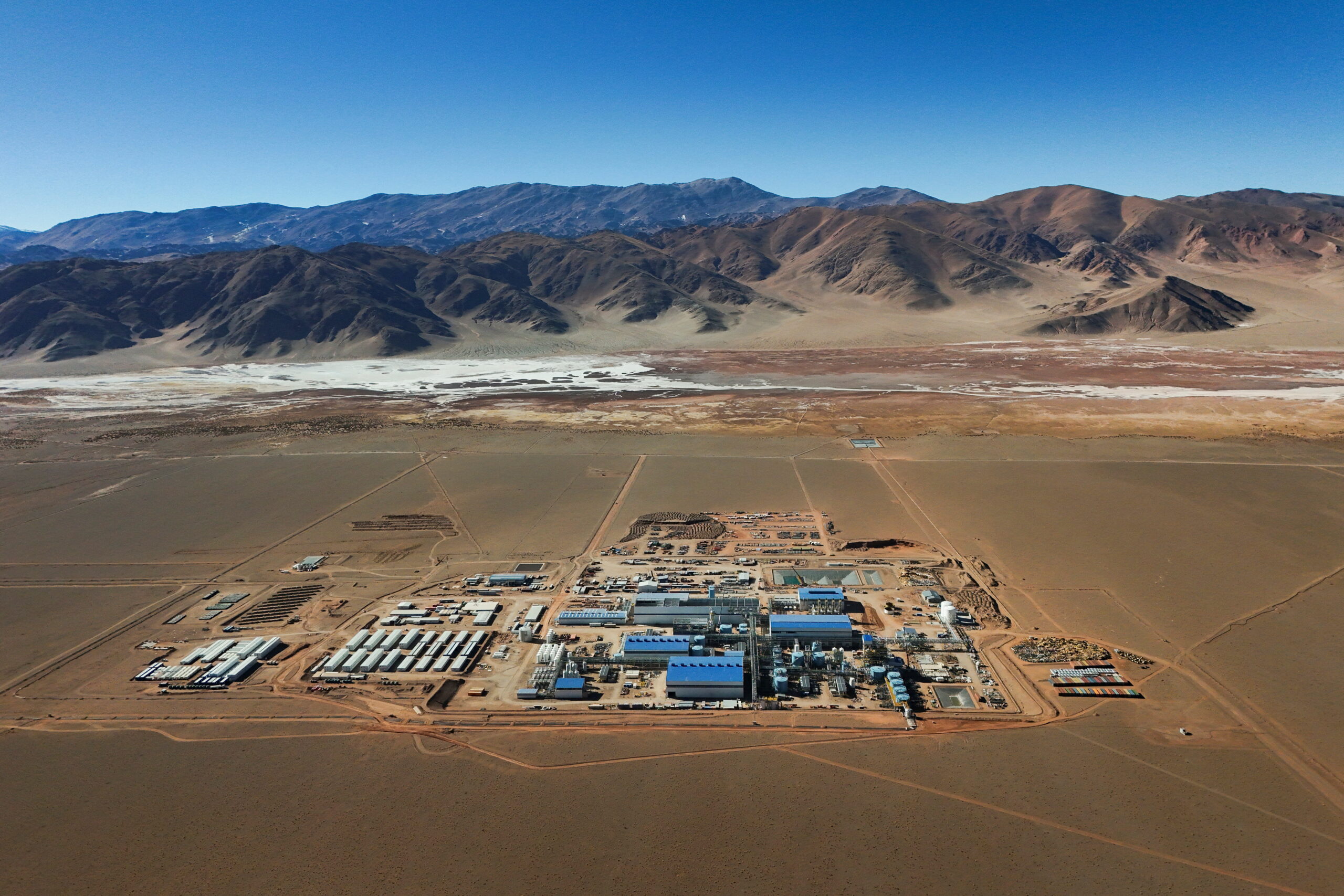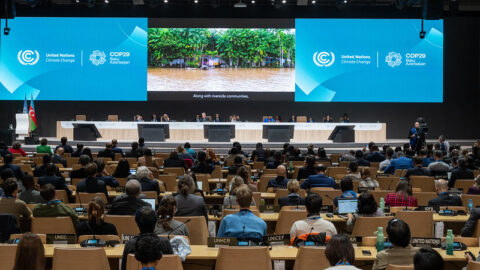Welcome to Carbon Brief’s DeBriefed.
An essential guide to the week’s key developments relating to climate change.
This week
Broken records
FIRES: Wildfires have burned through more than 1m hectares of land across the EU, making 2025 the worst year on record, the Guardian reported. Blazes in the EU have burned four times as much land this year as the average over the past two decades, according to data from the European Forest Fire Information System, the outlet said. Meanwhile, the UK has “almost certainly” faced its hottest summer on record, according to provisional Met Office data covered by BBC News.
FLOODS: At least 34 people have been killed as heavy rainfall across India and Pakistan continued to cause flash floods and landslides in Indian-controlled Kashmir, the Associated Press reported. Continuing extreme rainfall in China has caused more than $2bn in damages since July, noted Reuters. Typhoon Kajiki has killed at least eight people in Vietnam and Thailand, with more flash floods and mudslides expected, Channel News Asia reported.
Turbine turbulence
POWER SHOCK: Shares in the Danish wind-power developer Ørsted dropped to a record low after the Trump administration ordered the firm to stop work on a near-complete project, the Financial Times reported. The $1.5bn Revolution Wind project is four-fifths complete and was due to power 350,000 homes in Rhode Island and Connecticut, the newspaper said.
‘WINDFARM WASTE’: In the UK, the energy regulator Ofgem announced that energy bills will rise by 2% for millions of households in October, with the Times reporting that part of the increase is due to the rising cost of “paying wind farms to switch themselves off”. The news sparked a wave of critical editorials and comment pieces in right-leaning and climate-sceptic UK newspapers. A Carbon Brief factcheck previously explained how gas prices, rather than “balancing costs” associated with wind farms, are the largest driver of high electricity prices in the UK.
Around the world
- FORESTS FOREVER: At a summit in Colombia, Brazil won the backing of other Amazon nations for its $125bn “Tropical Forests Forever Facility”, a fund first launched at COP28 in 2023, Bloomberg reported.
- CHINA CAP: China’s cabinet announced that the country will “tighten its carbon trading market by introducing absolute emissions caps in some industries for the first time starting by 2027”, Reuters said.
- RECORD RENEWABLES: Global renewables investment increased by 10% in the first half of the year, when compared to last year, to a record $386bn, according to new data from BloombergNEF covered by BusinessGreen.
- BANKING BREAK: The Net-Zero Banking Alliance has “paused” its activities “after losing top European and Wall Street members amid Trump’s ongoing crusade against climate change”, reported the Financial Times.
- STAFF SUSPENDED: The US Federal Emergency Management Agency (Fema) has suspended more than 20 members of staff who signed an open letter warning that Trump’s cuts to the body could risk a “national catastrophe” on the scale of Hurricane Katrina, according to BBC News.
87%
The percentage of new coal-power capacity located in China or India that came online globally in the first half of 2025, as revealed in a guest post for Carbon Brief written by Global Energy Monitor researchers.
Latest climate research
- Exposure to heatwaves may cause people to age faster | Nature Climate Change
- The number of supercell thunderstorms – the “most hazardous thunderstorm category” – could increase by an average of 11% in Europe under 3C of global warming | Science Advances
- Sea level rise projections from the Intergovernmental Panel on Climate Change (IPCC) second assessment in 1995 were “strikingly close to what transpired over the next 30 years” | Earth’s Future
(For more, see Carbon Brief’s in-depth daily summaries of the top climate news stories on Tuesday, Wednesday, Thursday and Friday.)
Captured

Carbon Brief published an in-depth factcheck debunking 16 of the most commonly heard false and misleading myths about solar power. One such claim is that solar power poses “a serious threat to agriculture and food security” by taking up land. The chart above, adapted from the factcheck, puts such a claim in perspective using the land-use of golf courses as a comparison.
Spotlight
How to reform the UN’s climate COPs
This week, Carbon Brief highlights a short extract from a new autobiography written by the late Peter Betts, who was the UK and EU lead negotiator at various COPs, including 2015’s pivotal COP21 in Paris. Betts, who died of brain cancer in October 2023, used his book to lay out his views on how to reform COPs – a topic Carbon Brief recently asked a range of experts about, too.
Of course, the UNFCCC and COP process has its shortcomings. For example, I would be the first to acknowledge that progress on finance, adaptation and loss and damage has been too slow. But I would argue that it would not have happened at all without the central global discussion afforded by the COPs, at which vulnerable countries always have a strong voice.
The alternative to COPs – often put forward by big and powerful countries – is to do everything within the G20, perhaps complemented by plurilateral cooperation between big states. No one would be more pleased to see the end of the COP process than big oil and gas interests in the US who sought to undermine COPs throughout my decade or more in negotiations.
My experience was that excluding the vulnerable countries led to lower-ambition outcomes which the US and emerging economies were comfortable with. The vast bulk of vulnerable countries would be horrified to lose the COPs, since it guarantees them a voice.
Overall, then, I believe that the case for keeping a global forum, where all have a seat at the table and, therefore, the most vulnerable have a voice, is overwhelming, and this is the UNFCCC. It is an indispensable political moment every year to rally the forces of ambition for climate change (and, to paraphrase Voltaire, if we didn’t have it, we would need to invent it). There are, however, two improvements that could be made to the way COPs operate.
1: The second stocktake
Formal stocktakes occur every five years, at a point two years before the next five-yearly ambition cycles of the COPs (such as Paris and Glasgow). But there is almost no focus by the media or NGOs on the announcements of NDCs [nationally determined contributions], especially those of “developing countries”, despite the importance of NDCs’ impact on climate goals.
In the run-up to the five-yearly stocktakes there should be a moment, perhaps a third of the way through the year, where we can see where we stand, individually and collectively, following the NDCs that have been announced. If some countries’ proposals are weak, those countries should be pressured to do more; if some have not submitted a proposal at all, then that should be highlighted.
It seems unlikely that the big economies would agree a formal process change, as when I have suggested such a second stocktake “moment” to various partners they have expressed concerns that it would be controversial. However, civil society should look to create this moment outside the formal process with analysis and media-friendly events which would provide an opportunity to assess (and put pressure on) relative, proposed contributions.

2: Annex membership
Second, we should review membership of the annexes to the convention, which set out who is “developed” and who is a “developing” country. We need a step change in support for emerging economies to help them make the transition to low carbon, which is increasingly affordable and will bring them other benefits. This means much more finance from Annex II countries, complemented by finance from China (the world’s biggest sovereign investor) and from Gulf states, who have grown rich on selling fossil fuels.
Sadly, however, I doubt whether it will be possible to negotiate changes to membership of the annexes, even though that was required by the convention to happen by 1998. But could countries such as China and the Gulf states not voluntarily step into Annex I and/or even Annex II?
Non-Annex I countries now constitute nearly two-thirds of global emissions and are likely to be a far higher proportion of emissions growth. So, if we want to limit climate change, it is these emissions we need above all to target. Of course, we must complement this by quicker action by Annex I countries, perhaps alongside negative emissions, and we must provide much more serious help to some non-Annex I countries.
Adapted from The Climate Diplomat: A Personal History of the COP Conferences by Peter Betts, published by Profile on 28 August and available now.
Watch, read, listen
KATRINA: Twenty years on from the category-five hurricane that devastated New Orleans, the Times had a lengthy feature about the “flood, failures and chilling aftermath”. Netflix also released a three-part series about the disaster.
SLOP: DeSmog investigated the websites using AI-generated content citing non-existent climate experts and institutions.
FAILED MODEL: Pakistani journalist Arifa Noor lamented in Dawn the “development model” being adopted by the nation’s “ruling elite” amid the “rage of climate change”.
Coming up
- 31 August-5 September: Africa Food Systems Summit, Dakar, Senegal
- 1 September: Guyana elections
- 3 September: Jamaica general election
- 5-10 September: Africa Climate Summit 2, Addis Ababa, Ethiopia
Pick of the jobs
- World Weather Attribution, media relations manager | Salary: £46,614-£56,345. Location: London/hybrid
- Wood Mackenzie, research analyst – solar supply chain, power & renewables | Salary: Unknown. Location: Shanghai
- Conservation Law Foundation, vice president for clean energy and climate change | Salary: $136,000-$175,000. Location: Boston, US
- London School of Economics, head of Climate and Growth Initiative | Salary: £53,949-£62,160. Location: London
DeBriefed is edited by Daisy Dunne. Please send any tips or feedback to debriefed@carbonbrief.org.
This is an online version of Carbon Brief’s weekly DeBriefed email newsletter. Subscribe for free here.
The post DeBriefed 29 August 2025: Record wildfires; Solar myths factchecked; Climate veteran on COP reform appeared first on Carbon Brief.
DeBriefed 29 August 2025: Record wildfires; Solar myths factchecked; Climate veteran on COP reform
Climate Change
Efforts to green lithium extraction face scrutiny over water use
Mining companies are showcasing new technologies which they say could extract more lithium – a key ingredient for electric vehicle (EV) batteries – from South America’s vast, dry salt flats with lower environmental impacts.
But environmentalists question whether the expensive technology is ready to be rolled out at scale, while scientists warn it could worsen the depletion of scarce freshwater resources in the region and say more research is needed.
The “lithium triangle” – an area spanning Argentina, Bolivia and Chile – holds more than half of the world’s known lithium reserves. Here, lithium is found in salty brine beneath the region’s salt flats, which are among some of the driest places on Earth.
Lithium mining in the region has soared, driven by booming demand to manufacture batteries for EVs and large-scale energy storage.
Mining companies drill into the flats and pump the mineral-rich brine to the surface, where it is left under the sun in giant evaporation pools for 18 months until the lithium is concentrated enough to be extracted.
The technique is relatively cheap but requires vast amounts of land and water. More than 90% of the brine’s original water content is lost to evaporation and freshwater is needed at different stages of the process.
One study suggested that the Atacama Salt Flat in Chile is sinking by up to 2 centimetres a year because lithium-rich brine is being pumped at a faster rate than aquifers are being recharged.
Lithium extraction in the region has led to repeated conflicts with local communities, who fear the impact of the industry on local water supplies and the region’s fragile ecosystem.
The lithium industry’s answer is direct lithium extraction (DLE), a group of technologies that selectively extracts the silvery metal from brine without the need for vast open-air evaporation ponds. DLE, it argues, can reduce both land and water use.
Direct lithium extraction investment is growing
The technology is gaining considerable attention from mining companies, investors and governments as a way to reduce the industry’s environmental impacts while recovering more lithium from brine.
DLE investment is expected to grow at twice the pace of the lithium market at large, according to research firm IDTechX.
There are around a dozen DLE projects at different stages of development across South America. The Chilean government has made it a central pillar of its latest National Lithium Strategy, mandating its use in new mining projects.
Last year, French company Eramet opened Centenario Ratones in northern Argentina, the first plant in the world to attempt to extract lithium solely using DLE.
Eramet’s lithium extraction plant is widely seen as a major test of the technology. “Everyone is on the edge of their seats to see how this progresses,” said Federico Gay, a lithium analyst at Benchmark Mineral Intelligence. “If they prove to be successful, I’m sure more capital will venture into the DLE space,” he said.
More than 70 different technologies are classified as DLE. Brine is still extracted from the salt flats but is separated from the lithium using chemical compounds or sieve-like membranes before being reinjected underground.
DLE techniques have been used commercially since 1996, but only as part of a hybrid model still involving evaporation pools. Of the four plants in production making partial use of DLE, one is in Argentina and three are in China.
Reduced environmental footprint
New-generation DLE technologies have been hailed as “potentially game-changing” for addressing some of the issues of traditional brine extraction.
“DLE could potentially have a transformative impact on lithium production,” the International Lithium Association found in a recent report on the technology.
Firstly, there is no need for evaporation pools – some of which cover an area equivalent to the size of 3,000 football pitches.
“The land impact is minimal, compared to evaporation where it’s huge,” said Gay.


The process is also significantly quicker and increases lithium recovery. Roughly half of the lithium is lost during evaporation, whereas DLE can recover more than 90% of the metal in the brine.
In addition, the brine can be reinjected into the salt flats, although this is a complicated process that needs to be carefully handled to avoid damaging their hydrological balance.
However, Gay said the commissioning of a DLE plant is currently several times more expensive than a traditional lithium brine extraction plant.
“In theory it works, but in practice we only have a few examples,” Gay said. “Most of these companies are promising to break the cost curve and ramp up indefinitely. I think in the next two years it’s time to actually fulfill some of those promises.”
Freshwater concerns
However, concerns over the use of freshwater persist.
Although DLE doesn’t require the evaporation of brine water, it often needs more freshwater to clean or cool equipment.
A 2023 study published in the journal Nature reviewed 57 articles on DLE that analysed freshwater consumption. A quarter of the articles reported significantly higher use of freshwater than conventional lithium brine mining – more than 10 times higher in some cases.
“These volumes of freshwater are not available in the vicinity of [salt flats] and would even pose problems around less-arid geothermal resources,” the study found.
The company tracking energy transition minerals back to the mines
Dan Corkran, a hydrologist at the University of Massachusetts, recently published research showing that the pumping of freshwater from the salt flats had a much higher impact on local wetland ecosystems than the pumping of salty brine. “The two cannot be considered equivalent in a water footprint calculation,” he said, explaining that doing so would “obscure the true impact” of lithium extraction.
Newer DLE processes are “claiming to require little-to-no freshwater”, he added, but the impact of these technologies is yet to be thoroughly analysed.
Dried-up rivers
Last week, Indigenous communities from across South America held a summit to discuss their concerns over ongoing lithium extraction.
The meeting, organised by the Andean Wetlands Alliance, coincided with the 14th International Lithium Seminar, which brought together industry players and politicians from Argentina and beyond.
Indigenous representatives visited the nearby Hombre Muerto Salt Flat, which has borne the brunt of nearly three decades of lithium extraction. Today, a lithium plant there uses a hybrid approach including DLE and evaporation pools.
Local people say the river “dried up” in the years after the mine opened. Corkran’s study linked a 90% reduction in wetland vegetation to the lithium’s plant freshwater extraction.
Pia Marchegiani, of Argentine environmental NGO FARN, said that while DLE is being promoted by companies as a “better” technique for extraction, freshwater use remained unclear. “There are many open questions,” she said.
AI and satellite data help researchers map world’s transition minerals rush
Stronger regulations
Analysts speaking to Climate Home News have also questioned the commercial readiness of the technology.
Eramet was forced to downgrade its production projections at its DLE plant earlier this year, blaming the late commissioning of a crucial component.
Climate Home News asked Eramet for the water footprint of its DLE plant and whether its calculations excluded brine, but it did not respond.
For Eduardo Gigante, an Argentina-based lithium consultant, DLE is a “very promising technology”. But beyond the hype, it is not yet ready for large-scale deployment, he said.
Strong regulations are needed to ensure that the environmental impact of the lithium rush is taken seriously, Gigante added.
In Argentina alone, there are currently 38 proposals for new lithium mines. At least two-thirds are expected to use DLE. “If you extract a lot of water without control, this is a problem,” said Gigante. “You need strong regulations, a strong government in order to control this.”
The post Efforts to green lithium extraction face scrutiny over water use appeared first on Climate Home News.
Efforts to green lithium extraction face scrutiny over water use
Climate Change
Maryland’s Conowingo Dam Settlement Reasserts State’s Clean Water Act Authority but Revives Dredging Debate
The new agreement commits $340 million in environmental investments tied to the Conowingo Dam’s long-term operation, setting an example of successful citizen advocacy.
Maryland this month finalized a $340 million deal with Constellation Energy to relicense the Conowingo Dam in Cecil County, ending years of litigation and regulatory uncertainty. The agreement restores the state’s authority to enforce water quality standards under the Clean Water Act and sets a possible precedent for dozens of hydroelectric relicensing cases nationwide expected in coming years.
Climate Change
A Michigan Town Hopes to Stop a Data Center With a 2026 Ballot Initiative
Local officials see millions of dollars in tax revenue, but more than 950 residents who signed ballot petitions fear endless noise, pollution and higher electric rates.
This is the second of three articles about Michigan communities organizing to stop the construction of energy-intensive computing facilities.
A Michigan Town Hopes to Stop a Data Center With a 2026 Ballot Initiative
-
Climate Change2 years ago
Spanish-language misinformation on renewable energy spreads online, report shows
-
Climate Change2 months ago
Guest post: Why China is still building new coal – and when it might stop
-
Climate Change Videos2 years ago
The toxic gas flares fuelling Nigeria’s climate change – BBC News
-

 Greenhouse Gases1 year ago
Greenhouse Gases1 year ago嘉宾来稿:满足中国增长的用电需求 光伏加储能“比新建煤电更实惠”
-
Greenhouse Gases2 months ago
Guest post: Why China is still building new coal – and when it might stop
-

 Climate Change1 year ago
Climate Change1 year ago嘉宾来稿:满足中国增长的用电需求 光伏加储能“比新建煤电更实惠”
-

 Carbon Footprint2 years ago
Carbon Footprint2 years agoUS SEC’s Climate Disclosure Rules Spur Renewed Interest in Carbon Credits
-
Renewable Energy3 months ago
US Grid Strain, Possible Allete Sale







